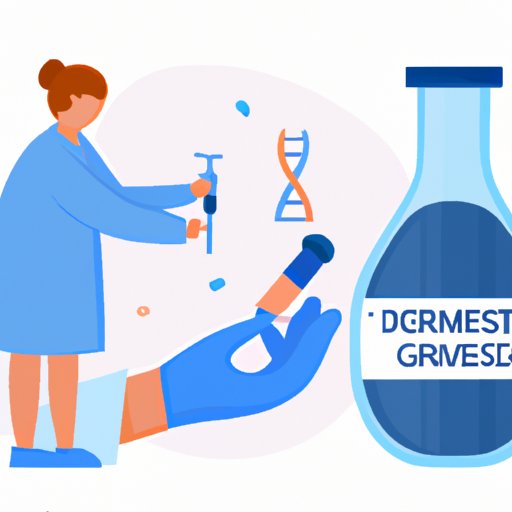
I. Introduction
Hereditary diseases are a common problem that affect millions of people all over the world. They are caused by genetic mutations that can be passed down from one generation to the next. This article aims to provide a comprehensive guide to hereditary diseases, including their causes, effects, and treatment options.
II. Understanding the Basics: A Guide to Hereditary Diseases
Hereditary diseases, also known as genetic diseases, are conditions that are caused by abnormalities in an individual’s DNA. These abnormalities can be inherited from one or both parents and can affect any part of the body. Some of the most common types of hereditary diseases include cystic fibrosis, sickle cell anemia, and Huntington’s disease.
Hereditary diseases can be caused by a variety of factors, including mutations in single genes or mutations that affect multiple genes. They can also be caused by chromosomal abnormalities and mitochondrial DNA mutations.

III. The Link Between DNA and Disease: Hereditary Disorders Explained
Our DNA contains the genetic information that determines everything from the color of our eyes to our susceptibility to certain diseases. Gene expression is the process by which the instructions contained within our DNA are used to produce proteins, which are essential for maintaining healthy cells and tissues.
Mutations are changes in our DNA that can interfere with gene expression and lead to hereditary diseases. These mutations can be inherited from one or both parents or can occur spontaneously during the formation of eggs or sperm. Mutations can also be caused by exposure to environmental agents, such as chemicals and radiation.
Genes are passed down from parents to children in pairs. Each parent contributes one copy of each gene, and the combination of genes determines the traits that a child inherits. If one or both parents carry a mutation that causes a hereditary disease, their children are at risk of inheriting the condition.
IV. When Genetics Go Wrong: The Impact of Hereditary Diseases
Hereditary diseases can have a significant impact on the individuals and families affected by them. In addition to the physical symptoms of the disease itself, hereditary diseases can also cause emotional stress and strain on relationships.
Healthcare professionals who treat hereditary diseases include genetic counselors, medical geneticists, and specialist physicians who are trained in managing specific conditions. Treatment options for hereditary diseases vary depending on the specific condition but may include medications, dietary changes, surgery, and physical therapy. In some cases, bone marrow or organ transplantation may be necessary.
V. Breaking Down the Science: How Hereditary Diseases are Inherited
Hereditary diseases can be inherited in different ways, depending on the specific gene mutations involved. Dominant genes are those that only require one copy to cause a disease, whereas recessive genes require two copies to manifest the disease.
Punnett squares are diagrams that can be used to predict the likelihood of inheriting a hereditary disease based on the genetic makeup of the parents. Punnett squares take into account the dominant or recessive nature of the gene(s) that determine the disease.
Examples of how hereditary diseases are passed down through generations include sickle cell anemia, which is caused by a mutation in the HBB gene, and Huntington’s disease, which is caused by a mutation in the HTT gene.
VI. Unraveling the Mysteries of Hereditary Illnesses
Research on hereditary diseases is ongoing, and scientists are making significant strides in understanding the causes and mechanisms of these conditions. Advancements in genetic testing and sequencing technology have made it possible to identify mutations that cause hereditary diseases more quickly and accurately than ever before.
Some possible advancements and treatments that could emerge from research include gene therapy, which uses DNA to treat genetic disorders, and personalized medicine, which uses an individual’s genetic makeup to tailor treatment to their specific needs.
VII. Living with Genetic Risk: Perspectives on Hereditary Diseases
Living with a hereditary disease can be challenging, and individuals and families affected by these conditions often face unique emotional and practical challenges. Personal stories and perspectives from people who have experience with hereditary diseases can be a valuable source of support and encouragement.
In addition, support options for individuals and families affected by hereditary diseases include healthcare professionals, support groups, and online communities. These resources can provide valuable information, emotional support, and practical advice for managing the challenges of living with a hereditary disease.
VIII. Conclusion
Hereditary diseases are a complex and often challenging issue for individuals and families affected by them. However, with a greater understanding of the causes, effects, and treatment options for hereditary diseases, it is possible to manage these conditions and live a full and meaningful life.
For more information on hereditary diseases, speak with a healthcare professional, genetic counselor, or visit reputable online resources.





